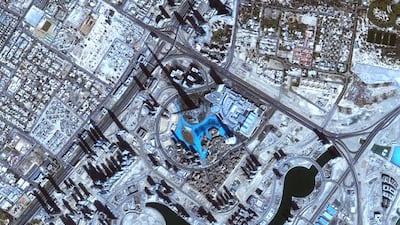Images from the Mohammed bin Rashid Space Centre’s earth observation satellites are being used to fight climate change and inform urban planning and disaster management worldwide.
Scientists at the MBRSC presented findings from DubaiSat1 and DubaiSat2 coupled with their research to help international organisations improve disaster-stricken areas and further the UN’s Sustainable Development Goals.
"Climate action is one of the goals – the images we provide to the world can help support mitigation of climate change and help monitor, rescue and analyse disaster-stricken areas," said Noora Al Rafi, the Centre's head of studies.
The UN used some of the images when a tsunami hit Japan's coastline in 2011. "We can provide our pictures to researchers and other government entities who then can conduct studies on that," said Mariam Al Zarouni, an engineer in policies and studies at the centre.
"It depends what's requested but we could provide images from anywhere in the world. For the tsunami, we were able to provide some of the pictures to the UN so they were able to plan for their disaster control and recovery."
The same applied to an earthquake that struck Pakistan a few years ago. "Our images were able to find the place, the depth of the earthquake itself and the depth of the floods," Ms Al Rafi said. "They can then analyse that using our images."
The centre is also contributing to the UN's SDGs in the field of clean energy.
The centre built an off-the-grid eco-friendly "Passive House" for hot and humid climates at its premises in Al Khawaneej. The project won the 2017 Mena Green Building Award under the category Green Residential Building this year.
"It's a proof of concept that the house is completely off the Dewa grid in terms of water and electricity," Ms Al Zarouni said. "It depends on solar panels and it's a passive cooling and heating house so it's not just related to Earth observation but it's a proof of concept that it can be used here."
In education, the centre provides undergraduates with a programme allowing them to build their own satellite, in an aim to link industry to the government.
In gender equality, around 40 per cent of the centre's employees are female, including a third of its deputy project managers, along with 35 per cent at Emirates Mars Mission, compared to 11 to 14 per cent at Nasa.
The women spoke of space as one of the most vital sectors for the UAE's growth. "Space technologies not only feed the sector itself but also feeds other sectors like health, education and military," Ms Al Rafi said. "So any development in this sector helps others improve and this is what we want. It's also directly supporting the knowledge-based economy transformation of the country."

